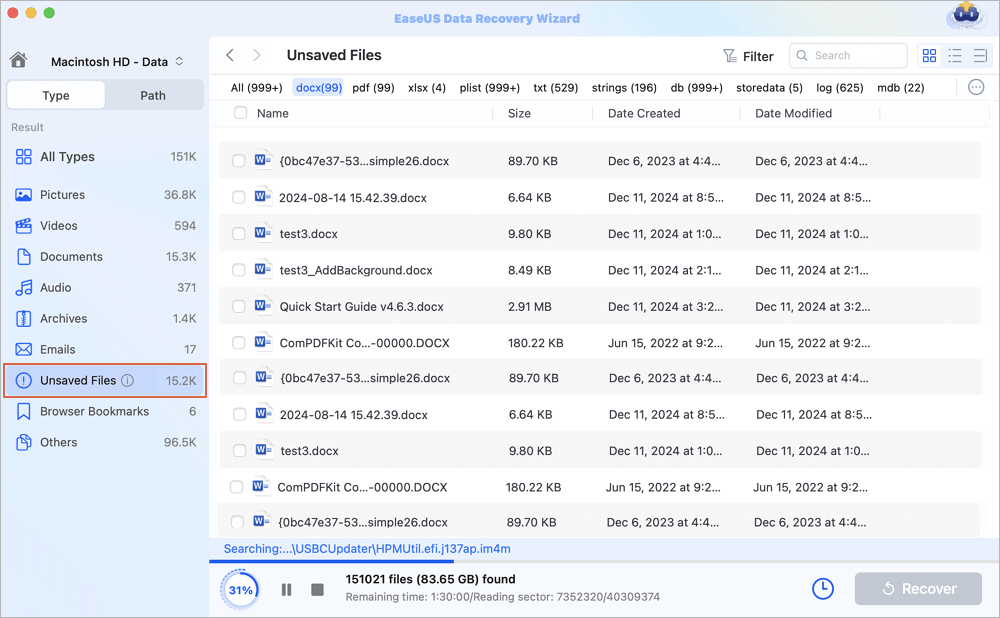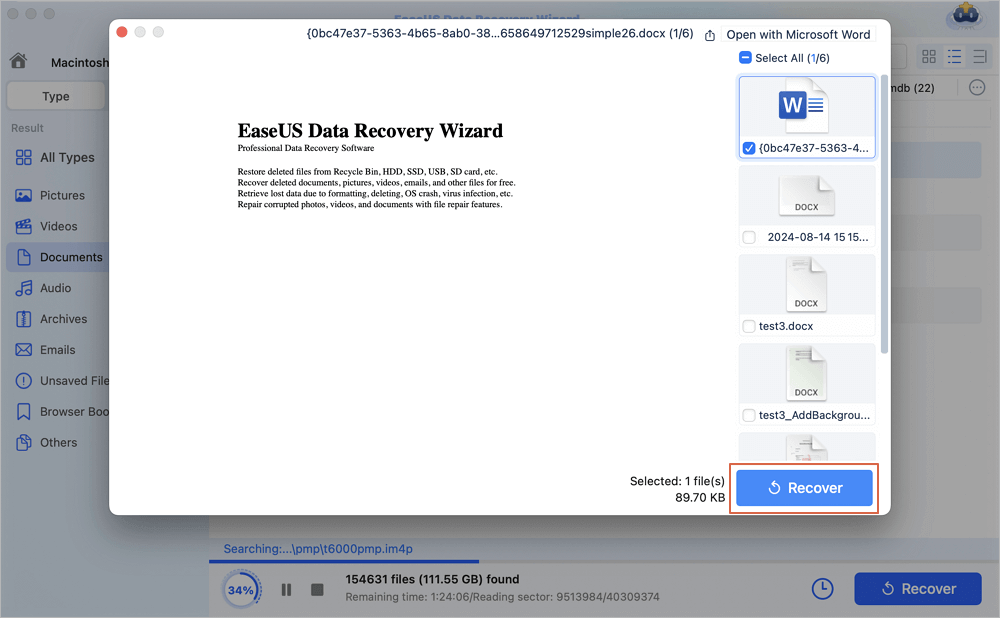Many people reported the error "The document could not be autosaved" when they edited a document on their Mac. If this error occurs to you, don't worry!
I get this message whenever I work on a document in Pages that is located on Google Drive: "The document "document name" could not be autosaved. The file has been changed by another application". From Apple Community
This post will guide you on how to fix the "document could not be autosaved" problem and, the top-priority part, recover the unsaved document without data loss.
Recover the Unsaved Document with EaseUS Software
If the "could not be autosaved" error happens, and you didn't save the documents manually, don't panic! You can choose a professional and safe document recovery tool, EaseUS Data Recovery Wizard for Mac, to recover unsaved documents with clicks.
The EaseUS software can recover unsaved Word documents, unsaved Excel files, and more document types. To avoid losing the changes of the edited documents, install EaseUS software and follow the steps below to recover unsaved documents on your Mac:
Step 1. Select the disk
Launch EaseUS Data Recovery Wizard for Mac, hover the mouse over the device where you lost an unsaved file, and click "Search for lost files".

Step 2. Choose unsaved documents
After the scan, click "Type", and expand "Unsaved Documents". Click the exact file type - Word, Excel, Powerpoint, Keynote, Pages, or Numbers you lost without saving.

Step 3. Preview and recover unsaved files
Double-click to preview your unsaved file, select the right version and click "Recover" to save the file to another secure location on Mac.

This powerful document recovery tool can help users recover previous versions of Word documents, Excel files, PowerPoint files, and other documents.
It can recover unsaved iWork documents without advanced backups in Time Machine, such as recovering Mac Pages Autosave documents.
Share this article on social media to help others learn how to fix "The document could not be autosaved" on a Mac.
Clear Recent Menu to Fix the Document Not Autosaved Error
Clearing the recent menu may fix a document that could not be autosaved. Check out the following steps:
Step 1. Open the app that reminds you, "The document could not be autosaved", on your Mac.
Step 2. Click "File" on the top menu, and choose the "Open Recent" option.

You will see a list of files that you opened recently.
Step 3. Scroll down to the bottom and clear the recent menu.
Duplicate the Document that Could Not Autosaved
In this part, we provide a way to save the affected document without data loss; however, this method doesn't actually resolve the "could not be autosaved" error.
Open the document, click on the "Duplicate" option, and remember to save the new document in a different storage location rather than the original storage location, such as Photoshop autosave location on a Mac.

After saving the duplicate document, you can edit it rather than the original one to check if the autosave is working.
Disable the Autosave Option and Save Documents Manually
Another option is to turn off the autosave option and manually save the changes you have made to the file. This method ensures that your file will not lose data as long as you remember to click Save before exiting the edit.
Generally, you can see the autosave option in the window at the top left corner of the file app, and you can turn it off manually.

Conclusion
This article introduces how to recover unsaved documents with EaseUS Data Recovery Wizard for Mac and provides effective ways to fix the documents that could not be autosaved on Mac issue: learning the recent menu, duplicating the document that could not be autosaved, and disabling the "Autosave" option in document apps.
The Document Could Not Be Autosaved FAQs
Here are questions people also ask when they search for how to solve the "document could not be autosaved" error:
1 . Why won't my document AutoSave on Mac?
If your documents are locally saved on your Mac, you won't be able to use the "Autosave " feature. Another possible reason is your documents are stored in the local folder and failed to upload to your cloud drive.
2. Why does Pages says "document could not be autosaved"?
If you are using Google Drive, you should notice that Pages' autosave feature is designed to work with a supported filesystem format, which doesn't include Google Drive. You can autosave the Pages documents in your iCloud Drive.
Was This Page Helpful?
Brithny is a technology enthusiast, aiming to make readers' tech lives easy and enjoyable. She loves exploring new technologies and writing technical how-to tips. In her spare time, she loves sharing things about her game experience on Facebook or Twitter.
-
EaseUS Data Recovery Wizard is a powerful system recovery software, designed to enable you to recover files you’ve deleted accidentally, potentially lost to malware or an entire hard drive partition.
Read More -
EaseUS Data Recovery Wizard is the best we have seen. It's far from perfect, partly because today's advanced disk technology makes data-recovery more difficult than it was with the simpler technology of the past.
Read More -
EaseUS Data Recovery Wizard Pro has a reputation as one of the best data recovery software programs on the market. It comes with a selection of advanced features, including partition recovery, formatted drive restoration, and corrupted file repair.
Read More
Related Articles
-
Top 11 Tools to Recover Deleted Partitions on Mac
![author icon]() Daisy/Dec 15, 2025
Daisy/Dec 15, 2025 -
How to Restore Notes from Backup on a Mac [with 4 Tested Methods]
![author icon]() Brithny/Dec 12, 2025
Brithny/Dec 12, 2025 -
Caffeinate Mac: Use Terminal to Caffeinate Mac
![author icon]() Jaden/Dec 12, 2025
Jaden/Dec 12, 2025 -
How to Fix Time Machine Backup Error 19 With Nas
![author icon]() Jaden/Dec 12, 2025
Jaden/Dec 12, 2025